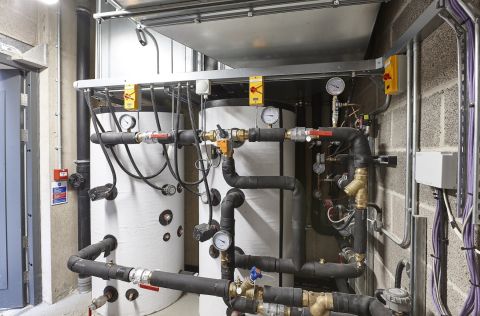Buying guide
Dehumidifiers
Four things to consider when buying a dehumidifier
It’s a delicate balance to maintain the ideal humidity in our homes. Everyday activities such as showering, washing up, boiling kettles and drying laundry indoors create a build-up of moisture in the home which can then be absorbed into the walls, effecting the integrity of the structure. Too damp, and you’re faced with mould and mildew issues, too dry and you could experience dust mites, dry skin and it can even effect your furniture. This handy guide will help eliminate the jargon and help you decide what dehumidifier is best for you and your family.
Why do you need a dehumidifier?
To help you figure out what capacity and extraction rates you require, you will first need to identify why you need to invest in a dehumidifier. For example, if you’re experiencing peeling wallpaper in your bedroom (with an adjoining ensuite) you may opt for a dehumidifier with a larger capacity and higher extraction rate as this room likely suffers from a moderate to high level of humidity in comparison to an average room.
Prevent damp and condensation
A dehumidifier will noticeably reduce both condensation and damp, as well as preventing them from returning.
Prevent mould and mildew
Keeping the humidity levels under control will prevent mould, mildew and harmful bacteria from occurring in your home.
Assist with laundry drying indoors
By reducing moisture in the room, dehumidifiers speed up the drying process, so you can enjoy clean and dry clothes sooner. You can even use the water from the water tank.
What types of technology are there?
There are two main types of ‘whole room’ dehumidification technology that are used for domestic applications: compressors and desiccant. Dimplex dehumidifiers utilise compressor technology which is the most common as they are more affordable, cost effective to run and offer a wider variety of extraction rates.
What size do you need?
All dehumidifiers in the UK are measured at their ability to remove moisture over a 24 hour period set at either 30oC/80% relative humidity (RH) or 32oC/ 80% relative humidity. These extraction rates refer to tropical conditions rather than those found in the UK. In tropical countries, you would typically expect to remove high levels of moisture compared to a cooler climate. In the UK, the average extraction requirements are around 2 litres per day, depending on the amount of occupants.
As a general rule of thumb the following will provide a guide:
All Dimplex dehumidifiers have been engineered and optimised to operate at typical UK climatic conditions lower temperatures and humidity levels. You should refer to each product technical specification to see how extractions rates vary at lower temperatures and humidity levels.
What are the key features to look out for?
Dehumidifiers are often packed with handy features that will help maximise your use and the lifespan of the product. See below for some key features to bear in mind when purchasing your dehumidifier:
- Control options: most dehumidifiers feature easy to use on/off controls, with some incorporating adjustable humidistats that enable you to control the desired humidity level in the room.
- Continuous option/drain - this is a setting where the product can be set to permanently run regardless of humidity level. This is feature is ideal if there is a serious damp problem e.g. as a result of flood damage. In addition to this, a drainage hose can be connected (sold separately) to the dehumidifier to allow for high levels of moisture to be drained efficiently.
- Auto shut off/tank full indicator - this is a feature where the float switch in the tank switches the machine off once the maximum water level has been reached. An indicator light will also illuminate to show if the tank is full.
- Defrost mode –this built in feature switches the compressor off to stop the possible build up of frost on the coils.
- Pre-filter - this is usually a washable filter that captures objects such as dust and hair, preventing these getting inside your product.
- Integrated carry handles and castors – these enable easy movement of your product around the home for ultimate convenience.
- Warranty - all Dimplex dehumidifiers come with a 3 year warranty (standard one year with a two year extension upon registration).

Boris Johnson’s Ten Point Plan: Clean and green, but is it enough to support the decarbonisation of heat?
Boris Johnson has launched his Ten Point Plan for a green industrial revolution. Ahead of COP26, this aims to show how committed Government is in making the UK a world leader in sustainability. But will this plan finally offer the infrastructure needed for the decarbonisation of heat?

How do we maximise the potential of heat pump technology to help us achieve net-carbon objectives?
The roadmap to achieve the UK’s 2050 net-zero carbon target is still relatively unclear. This creates uncertainty about the implementation of low carbon solutions in the industry. The lack of direction in turn affects the ability to plan for future developments. Difficult specification choices, doubts over futureproofing strategies, and lack of preparedness for regulatory changes, are just some of the factors affecting heat pump specification in new developments and existing buildings in both residential and commercial sectors.

Which technologies are the most viable to deliver the decarbonisation of heating?
To deliver the decarbonisation of heating, we should deploy a wide range of technologies that can help to eliminate the use of high carbon fossil fuels. Electric solutions, especially those that utilise renewable energy, offer a viable route to ensuring our homes are heated in a low carbon way. To successfully transfer to electrical infrastructures and make the necessary adjustments that bring us closer to achieving the UK’s 2050 net zero target, the industry will need a clear plan with achievable interim targets.











